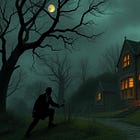The Confabulannotated Sherlock Holmes, Chapter 3.1
Featuring unladylike arithmetic, butcher meteorology and 1950s novelty hits
NOTE: If you have received this via email, you may find it easier to read the confabulannotations online by clicking on the title above.
Previously on my confabulannotations of Sir Arthur Conan Doyle’s Sherlock Holmes mystery, The Hound of the Baskervilles: Dr Mortimer made claims about footprints!
And now, the story continues…
Chapter 3 - The Problem
I confess at these words a shudder passed through me. There was a thrill in the doctor’s voice which showed that he was himself deeply moved by that which he told us. Holmes leaned forward in his excitement and his eyes had the hard, dry glitter which shot from them1 when he was keenly interested.
“You saw this?”
“As clearly as I see you2.”
“And you said nothing?”
“What was the use?”
“How was it that no one else saw it?”
“The marks were some twenty yards from the body and no one gave them a thought. I don’t suppose I should have done so had I not known this legend.”
“There are many sheepdogs on the moor3?”
“No doubt, but this was no sheepdog.”
“You say it was large?”
“Enormous.”
“But it had not approached the body?”
“No.”
“What sort of night was it?”
“Damp and raw4.”
“But not actually raining?”
“No.”
“What is the alley like?”
“There are two lines of old yew hedge, twelve feet high and impenetrable5. The walk in the centre is about eight feet across.”
“Is there anything between the hedges and the walk?”
“Yes, there is a strip of grass about six feet broad on either side6.”
“I understand that the yew hedge is penetrated7 at one point by a gate?”
“Yes8, the wicket-gate9 which leads on to the moor.”
“Is there any other opening?”
“None.”
“So that to reach the yew alley one either has to come down it from the house or else to enter it by the moor-gate?”
“There is an exit through a summerhouse10 at the far end.”
“Had Sir Charles reached this?”
“No; he lay about fifty yards from it.”
To the disappointment of many fans, Holmes’ glitter-vision power was shamefully underused in the rest of his stories, with Moriarty, to take the most obvious example, not once experiencing the full brunt of a blast of Sherlocular Sparkles™.
In addition to the glitter-vision, Holmes was also completely transparent at this point in continuity.
‘How Many Sheepdogs Are On The Moor?’ was a novelty hit for Jenny Jiggle and The Vacuum Tube Trio in 1954. The answer, at least according to the song, was ‘three-hundred and seventy-four, or maybe less, but certainly not more (that’s how many sheepdogs are on the moor)’.
For a brief period of time in the early 1900s, it was considered the height of English wit to compare the weather to the quality of one’s favourite sausage. At the peak of this trend, it was not uncommon for butchers to loiter around abattoirs, conducting Sky and Cloud Prognostication Exhibitions eerily similar to modern day weather forecasts, except, of course, for the plentiful and wayward wielding of offal.
Much like, one imagines, this entire line of questioning from Holmes.
These kind of precise descriptions thrilled a certain kind of cartographical-minded fan, who would spend hours translating them into detailed diagrams, drawn accurately and to scale. They would then try to recoup their costs by selling these visual aid representations to fellow Holmes readers at local markets and penny bazaars. This was despite Conan Doyle’s furious and foul-mouthed protestations which, in at least one known case, escalated to physical blows and attempted arson.
An obvious trap, given that Dr Mortimer earlier claimed the yew hedge to be impenetrable. Too obvious, surely, for the doctor to fall into.
Oops!
At the time, numerous England manors had gates named after their favourite Ewoks.
A ‘summerhouse’ was a dwelling at the rear of a nobleman’s grounds, in which the master of the manor would retire in private to add numbers (such as 37 and 54, or 12 and 81). He undertook these sums, confident in the knowledge that he would not be interrupted by his wife or daughters or still room maids, for even basic arithmetic was considered at the time to be an unladylike pursuit. ‘You’ll ne’er add a husband, if you’re caught adding digits’ as the saying went.



